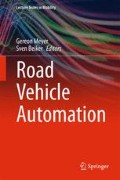Abstract
In the past years various partially automated driving functions have been introduced on the market. More advanced functions are currently in research. By means of these functions partly automated driving in specific driving situations is already realized, e.g. a traffic jam assist performs longitudinal and lateral control at low speeds. Besides the technical challenges to realize automated driving in complex driving situations, e.g. intersection areas, new approaches to evaluate these functions under different driving conditions are necessary, in order to assess the benefits and identify potential weaknesses. In this context, this chapter describes a systematic approach to evaluate road vehicles with automated driving functions. The presented approach is divided into a technical, a user-related and an impact evaluation.
Access this chapter
Tax calculation will be finalised at checkout
Purchases are for personal use only
References
Rowsome F (1958, April) What it’s like to drive an auto-pilot car. Popular Science Monthly, USA
Unselt T, Breuer J, Eckstein L, Frank P (2004) Avoidance of “loss of control crashes” through the benefit of ESP.In: FISITA Conference paper no. F2004V295
N.N., Daimler (2008) 20 Prozent weniger Auffahrunfälle durch DISTRONIC PLUS und Bremsassistent PLUS, Press Release
Maurer M, Behringer R, Fürst S, Thomanek F, Dickmanns ED (1996) A compact vision system for road vehicle guidance. In: Proceedings of ICRP, IEEE, New York
Bertozze M, Broggi A, Fascioli A (2000) Vision-based intelligent vehicles: State of the art and perspectives. Robot Auton Syst 32(1):1–16
Markoff J (2010, October 9) Google Cars drive themselves, in traffic. The New York Times
Winner H (2011) Die Freigabefalle des autonomen Fahrens. In: 5. Darmstädter Kolloquium, Technische Universität Darmstadt
Eckstein L, Zlocki A (2013) Safety potential of ADAS—combined methods for an effective evaluation. ESV 2013, Seoul, South-Korea
Knapp A, Neumann M, Brockmann M et al (2009) Code of practice—design and evaluation of ADAS. PReVENT Response 3
N.N., ISO 26262 (2011) Road vehicles—Functional safety
Zlocki A, Eckstein L (2013) Combined methods for an effective evaluation of automated driving functions. In: TRBs second annual workshop on road vehicle automation. Stanford
N.N., National Highway Traffic Safety Administration (NHTSA) (2013) Preliminary Statement of Policy Concerning Automated Vehicles
Donges E (1978) Aspekte der aktiven Sicherheit bei der Führung von Personenkraftwagen. Automobil- Industrie 2/2
N.N., Forschungsgesellschaft Kraftfahrwesen mbH Aachen (fka) (2010) PELOPS White Paper
Merat N, Jamson AH, Lai FCH, Carsten O (2012) Highly automated driving, secondary task performance, and driver state. Hum Factors 54(5):762–771
Endsley MR (1995) Toward a theory of situation awareness in dynamic systems. Hum Factors 37(1):32–64
Larsson P, Esberg I et al (2012) Interactive- test and evaluation plans. Interactive Deliverable D7.4
Wilmink I et al (2008) Impact assessment of intelligent vehicle safety systems. eIMPACT DL 4
Scholliers J et al (2008) PreVAL—Project final report and recommendations for future assessments. DL IP_D12/D16.4
Karabatsou et al (2007) A priori evaluation of safety functions effectiveness—methodologies. TRACE DL4.1.3
Fahrenkrog F, van Noort M et al (2013) Impact assessment methodology in interactive. In: 20th ITS World Congress 2013. Tokyo, Japan
Jungbluth A, Wille JM et al (2012) rateEFFECT, Entwicklung eines Werkzeuges zur Effizienzbewertung aktiver Sicherheit, AAET
Faber F, Jonkers E et al (2011) Analysis methods for user related aspects and impact assessment on traffic safety, traffic efficiency and environment. EuroFOT DL6.2, version 1.0
Fahrenkrog F, Zlocki A, Eckstein L (2014) Bewertung aktive Sicherheitssysteme vom Test zur Wirksamkeitsanalyse. Automobiltechnische Zeitschrift
Kates R, Jung O, Helmer T et al (2010) Stochastic simulation of critical traffic situations for the evaluation of preventive pedestrian protection systems. VDI report No. 2106
Author information
Authors and Affiliations
Corresponding author
Editor information
Editors and Affiliations
Rights and permissions
Copyright information
© 2014 Springer International Publishing Switzerland
About this chapter
Cite this chapter
Zlocki, A., Fahrenkrog, F., Benmimoun, M., Josten, J., Eckstein, L. (2014). Evaluation of Automated Road Vehicles. In: Meyer, G., Beiker, S. (eds) Road Vehicle Automation. Lecture Notes in Mobility. Springer, Cham. https://doi.org/10.1007/978-3-319-05990-7_17
Download citation
DOI: https://doi.org/10.1007/978-3-319-05990-7_17
Publisher Name: Springer, Cham
Print ISBN: 978-3-319-05989-1
Online ISBN: 978-3-319-05990-7
eBook Packages: EngineeringEngineering (R0)

